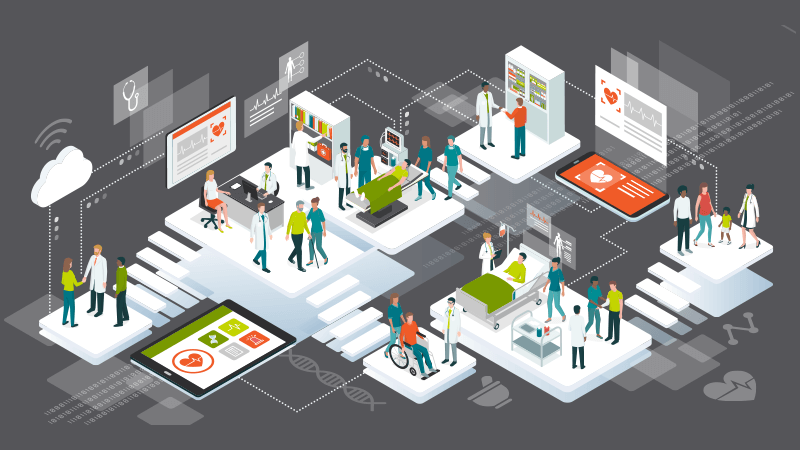
Healthcare facilities and providers’ main job is to offer quality patient care. However, challenges with exchanging data between systems can hinder healthcare professionals’ ability to do so. With large volumes of patient medical records, invoices, and incoming mail, transferring information using outdated methods can be time-consuming and inefficient.
According to The Pew Charitable Trusts and the Massachusetts eHealth Collaborative, most healthcare facilities have between 0.5 to 9 full-time employees who primarily manage patient records. That’s a lot of valuable time wasted handling physical documents. And the time wasted managing documents likely increased during the pandemic as more patients results in more documents. This is where healthcare interoperability comes in.
What healthcare interoperability is & why it’s important
Healthcare interoperability is the ability for various information systems, devices, and programs to access, exchange, integrate, and share data with one another. With interoperability, healthcare facilities can seamlessly exchange data across various departments, locations, and organizations.
With the right level of healthcare interoperability, patient information can be sent, received, found, and integrated into a healthcare facility’s electronic health/medical record (EHR/EMR) system. This makes finding required patient files easier and quicker than ever before – regardless of where the documents originate.
When a healthcare facility achieves interoperability, not only does it become easier for data to be shared across institutions, but it creates new opportunities for patients as well. Interoperability paves the way for patients to obtain easier access to their own information from various devices. In other words, it facilitates a whole new era of patient care.
The benefits of interoperability
By achieving interoperability, healthcare facilities significantly increase productivity by improving data accessibility and eliminating the need for employees to manually enter information from one system to another. The key benefits include:
- Better care coordination: With much easier access to information and much less manual work, healthcare interoperability results in far fewer miscommunications and errors.
- Improved decision-making: Healthcare facilities can obtain more accurate data faster, enabling professionals to make business and medical decisions more effectively.
- Better customer experience: No patient ever likes to be kept waiting and with the ability to obtain information more easily, caregivers can ensure that they’re not. Processes are expedited when employees no longer need to sift through files to find the one they need.
- Increased productivity: Manual work and efficiency do not go hand-in-hand. Fortunately, achieving healthcare interoperability results in the reduction of manual work and employee stress. These outcomes and efficiency do go hand-in-hand.
- Reduced costs: Bid farewell to paper-based health records and the unnecessary storage costs that come with them. When healthcare professionals can securely access digital documents from any device, there’s no need to maintain the physical versions of them. Interoperability also leads to decreased labor costs.
How to achieve healthcare interoperability
So, how can your healthcare facility get started in the process of achieving interoperability? Here are a few ways to attain interoperability in your organization:
Document scanning services and document management software
Digitizing patient files via medical record scanning services is the first step to achieving interoperability. Digitized records can be stored within secure document management software that integrates with your EHR/EMR system for easy access to historic patient information right from within the platform you’re already familiar with.
These solutions also help reduce data entry errors and prevent losing and mismatching records. The Pew Charitable Trusts found that 1 in 5 hospital chief information officers reports patients have been harmed due to record mismatches. When data is accurately uploaded and validated and all the patient information you need is right at your fingertips, the chance of files getting mismatched is much lower.
Accounts payable automation
With an accounts payable automation solution, your healthcare facility can skip the manual data entry and stressful exception handling that often comes with AP work. A trusted AP automation partner can handle the entire process for you – from invoice receipt through routing to the appropriate members of your team. The digital documents get loaded into your existing system, making accessing them a breeze and helping you to achieve the level of interoperability you need to reach your goals.
Workflow automation and RPA
Workflow automation and robotic process automation (RPA) eliminate tedious paper-based processes and facilitate data sharing between systems. RPA can be used to validate the information shared across multiple systems and automatically notify you of any errors, ensuring data accuracy. Automation closes gaps between platforms, cuts down manual tasks, and, ultimately, streamlines processes.
With over 30 years of experience, MetaSource is a global leader in digital transformation bringing the right mix of technology, expertise, and services to help you achieve increased efficiency in your healthcare facility. As a SOC 2 Type 2 certified and HIPAA compliant company, our processes are audited annually by a third party, ensuring service quality and document security for your healthcare organization.
Contact MetaSource to set up a call today to learn more about how we can help you achieve healthcare interoperability.
